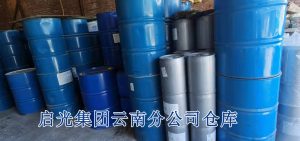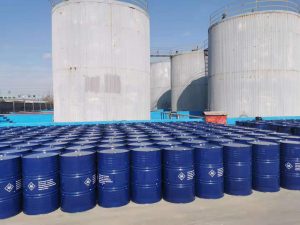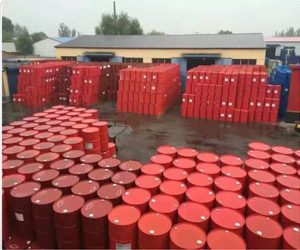Zinc isooctanoate
Synonyms: Zinc octanoate; Zinc 2-ethylhexanoate.
English name: zinc octoate; zinc 2-ethylhexanoate; zinc caprylate.
Molecular formula is C16H30O4Zn, molecular weight is 351.8. CAS No. 136-53-8.
Structural formula:
Physical and chemical properties
Pure or highly concentrated zinc isooctanoate is a pale yellow viscous liquid with a theoretical zinc mass fraction of 18.6%. Due to the high viscosity of pure zinc isooctanoate, it is not
Due to its high viscosity it is not easy to handle and can be used as a solution with a certain concentration of plasticiser.
The three zinc isooctanoate products, 825-4, 825-1 and 825-12, have a zinc content of (4.0±0.2)%, (9.0±0.2)% and (12.0±0.2)% respectively.
and (12.0±0.2)% respectively.
Shepherd’s zinc carboxylate catalyst, Bicat ZM, had a mass fraction of Zn of 18.3% to 19.7% and a relative density of

is 1.10~1.16, viscosity is about 10pa.s, insoluble matter content≦1.0%.
Characteristics and uses
Compared with traditional zinc naphthenate, it has the characteristics of light colour, low odour and high content. It has good properties when used in light coloured paints
It can reduce the colour and lustre of the paint film and improve the gloss. This product can be used in
It can be used as a catalyst for aliphatic polyurethane coatings and elastomers to promote cross-linking and shorten curing time. It is much less toxic than lead isooctanoate.

It can be used as a partial replacement for lead isooctanoate. The catalytic activity is lower than that of lead isooctanoate. The recommended dosage is 0.03% to 0.2% (metal to resin solids).
Improved general purpose polyurethane adhesives
The problem in the production operation of the above general-purpose two-component polyurethane adhesives is that the viscosity is more difficult to control, and if it cannot reach the target, the initial adhesive strength of the adhesive is poor, making it difficult to use. In addition, the general-purpose adhesive produces crystalline or flocculent bodies in winter, which need to be heated and melted before they can be used, thus causing problems for the user. After the improvement of the preparation method and the adjustment of the structure of polyester polyol, the above problems have been solved and the general-purpose two-component polyurethane adhesive has been made popular among users.
1. Preparation of A-component adhesive by chain expansion method
The moisture content of poly(adipic acid-ethylene glycol) reaches below 0.06% after vacuum dehydration treatment. The reaction temperature of TDI and polyester polyol is 90-95°C and the reaction time is 2h. According to the calculation, a chain extender of ethylene glycol (diethylene glycol) and dibutyltin dilaurate catalyst are added for the chain extender reaction to make the molecular weight (viscosity) increase further. The amount of solvent added and the method of addition are described in the preparation method above. The viscosity index of the A-component gum is stable and can be controlled by adding the amount of chain extender (diethylene glycol).
2. Low-temperature non-crystallisable A-component liquors
Instead of polyethylene glycol adipate, polyethylene glycol adipate can be used to prepare a component of the adhesive liquid at room temperature and low temperature of about zero degrees without crystals and flocculent, anti-freeze, will not crystallise. The molar ratio of ethylene glycol to propylene glycol in polyesters is 8:2 or 9:1.
Application examples
Universal two-component polyurethane adhesives can be used for bonding metals (e.g. aluminium, iron, steel, etc.), non-metals (e.g. ceramics, wood, leather, plastics, etc.) and for bonding between different materials. General two-component polyurethane adhesives are used in a large number of applications in the manufacture of electrical machinery insulation paper (polyester film – green shell paper composite), paper-plastic composite (color paper – polypropylene film), iron plate – polyurethane foam body composite and the manufacture of bristle brush, etc. Other uses penetrate into various areas of the national economy.
1. Machine tool guide maintenance
The use of inlay bonding plastic plate method will be plastic sheet glued to the cast iron guide, made of plastic guide, can solve the wear and tear of the machine tool guide. With iron anchor-10l polyurethane glue, according to the component A: component B = 100: 50 (quality parts) preparation of glue, mixed into the glue diameter∮ 0.1mm, 20mm long fine copper wire, so that the guide and plastic plate to maintain sufficient space between, not to cause all the glue extrusion. Plastic plate and cast iron rail two bonding surface need to be painted with glue twice, the first 5min after painting and then painted a second time, to be 15-20min its glue layer sticky after the phenomenon of drawing, and then the plastic plate and rail laminated, by its own weight pressure, because winter, summer temperature difference, will cause plastic expansion or shrinkage, internal stress and cracking, so the curing temperature is best to maintain between 20-25 ℃ The curing time is 1-2 days.

2. Bonding of loudspeakers
Speaker vibration system, that is, the carton, voice coil and positioning bracket three need to be glued together, especially high-power speakers vibration amplitude is large, so must be bonded firmly, because directly related to the service life of the speaker. Especially the loudspeakers above ∮100mm are bonded with polyurethane adhesive. The use of iron anchor – 101 polyurethane adhesive according to the component A: component B = 100: 30-35 (quality parts) with glue, the use of the expected results can be achieved. For the bonding of loudspeaker voice coils, the glue is prepared with A component: B component = 100:25 (parts per mass).
3. Application on bristle brush products
Universal two-component polyurethane adhesives are the ideal adhesive for bristle brushes. The bonding of the bristle brush is the bristle (pig bristles or nylon bristles, etc.), wood (wood) and brush shell (tinplate) three bonded together, requiring surface closure l-2mm, but also requires penetration of 6-9mm. commonly used adhesive formula: 100 parts of component A, 35 parts of component B, talc (≥ 160 mesh) 30 parts. The prepared adhesive will be poured into the brush shell or use the bristle brush grouting machine for potting, after potting shaking the brush head to make the adhesive uniform, placed until dry condensation (transferred to the beating hair not less than 24h). With the adhesive after sealing the brush bristle bonding strength is greater than 130N, to SG236 – 8l pig bristle paint brush standard provisions (98N), if soaked in acetone for 24h after not off the bristle, not loose, it means that the adhesive meets the requirements.
4. High-pressure strong plastic air duct bonding repair
Wire tying machine is the introduction of equipment, high-pressure strong plastic duct fracture often leads to equipment paralysis, affecting production. The use of nylon casing design butt, socket composite joint, both to meet the requirements of 0.8MPa pressure, but also to avoid the expansion of the nylon casing problem. Firstly, the 100mm long, inner diameter ∮2mm nylon casing and the inner wall ∮12mm (outer diameter) of the two ends of the high pressure plastic duct (50mm long outer wall) were roughly polished with emery cloth and cleaned with acetone, dried and then left to stick. Use iron anchor-101 polyurethane adhesive, glue according to the component A: component B = 5:1 (quality parts) preparation, first the broken high-pressure strong plastic duct end coated with glue, glue layer thickness 0.05-0.1mm, and then immediately insert the nylon casing into the high-pressure plastic duct glue end, and left and right rotation of the nylon casing, so that the glue evenly adhere to and fill the inner wall of the nylon casing and the gap between the high-pressure plastic duct, insert The depth of the nylon casing is half (50mm) of the other end of the high-pressure plastic duct, according to the above method of bonding, make sure that the two sections of the high-pressure plastic duct basically coincide, curing at room temperature for 48h, 100 ℃ to maintain 2h. The repair of the steel wire binding machine running for half a year did not see the bonding abnormalities, proved that the bonding can meet the requirements of 0.8MPa pressure working conditions.
5. The bonding and installation of low-temperature greenhouse electric light lines
The walls and ceiling of the low-temperature room are made of iron with a lacquered surface. The temperature of the room is -70-60°C, sometimes more than 10 days of continuous use. The temperature is 10-30°C and the relative humidity is 100% when it is not in use. The bonding process for low-temperature indoor press-fit electric light lines is briefly described below.
(1)Bonding surface treatment Use cutting tools, sandpaper to polish the rough surface, then clean with alcohol or acetone and dry.
(2)Adhesive preparation The iron anchor-101 polyurethane adhesive is prepared according to the component A: component B = 100: 20-30 (quality parts), plus coupling agent and other additives.
(3) Bonding Use a paintbrush to apply glue to the surface to be bonded, leave it to dry for 30-40min, attach the aluminium piece of the electric light line to the wall or ceiling and press it gently several times with fingers or other tools to make it bond firmly. Then apply a layer of adhesive to protect the primer where the aluminium is to be bonded. In addition, apply glue to the walls and concrete beams of the ceiling where the light socket is to be installed and then glue the socket to the walls and concrete beams and apply the appropriate pressure. In particular, the cement beams on the ceiling should be tightened with a wooden stick or other object.
(4) Curing Curing at room temperature for more than 48h. With this method of bonding the installation of electric light lines by more than years of practice, proved that the use of normal.
Magnetic material adhesive
Adhesive resins for magnetic recording media and their performance evaluation are shown in the table. These resins are not often used alone, but are generally mixed and have a good overall performance. Usually the resin composition consists of three parts: (1) components containing hydroxyl groups, such as epoxy resins, acrylic resins, polyester resins, chlorine vinegar resins, nitrocellulose, etc.; (2) polyisocyanate components that start the ammonia esterification reaction with the above-mentioned resins, such as diurethane-type, tri

